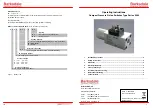
10
Spanning Tree Support
For an Ethernet network to work properly, only one active path can exist between two stations.
A network topology that contains redundant paths creates loops. When loops exist, broadcast
packets sent to all switches on the network are flooded back to the sending switch. As the
packets are broadcast, received, and rebroadcast by each switch on the network, the number of
packets traversing the LAN grows exponentially, creating a broadcast storm that saturates the
network and degrades performance.
The spanning tree protocol (STP) enables switches to break loops. Using STP, switch ports
identify a single primary path for communicating with a node. Any duplicate paths are placed in
standby (or “blocking”) mode. Packets are then sent and received through the primary path,
creating a loop-free environment. If a change in the network topology renders the primary path
unavailable
for example, if a network device fails, is removed, or is added
one of the
standby paths is activated.
Simple Network Management Protocol Management
The Simple Network Management Protocol (SNMP) is a set of communication protocols that
facilitate the exchange of management information between network devices (such as managed
switches). SNMP allows compatible products to be polled from a central management station
to gather information on their performance.
SNMP consists of two components: agents and managers.
An agent is software or firmware included with the SNMP-compliant device. The agent
monitors network operations, but does nothing else unless it is polled for information or
detects an error.
A manager is a sophisticated software application that collects and processes information
from many agents. It polls certain agents for information at regular intervals or only when
requested.
Remote Monitoring
SNMP gathers network data to determine whether SNMP-compliant devices are up or down.
Anything regarding traffic management and network performance variations, however, requires
additional tools. That's where RMON comes in.
Short for remote monitoring, RMON provides a standard method for monitoring the basic
operations of the network. With RMON, administrators can monitor, capture, and analyze real-
time information across the entire network using a management station at a central location.
A typical RMON configuration consists of a central network management station, called a
probe, and a remote monitoring device, called an RMON agent. As packets travel across the
network, an RMON agent installed in a compliant device (such as a managed switch)
continuously collects and analyzes network data and stores the statistics locally. This information
can be viewed using a probe.
The probe can be a workstation or PC running a network management application, such as
SNMPc. From the probe, an administrator can issue SNMP commands requesting information
from the RMON agent.
































